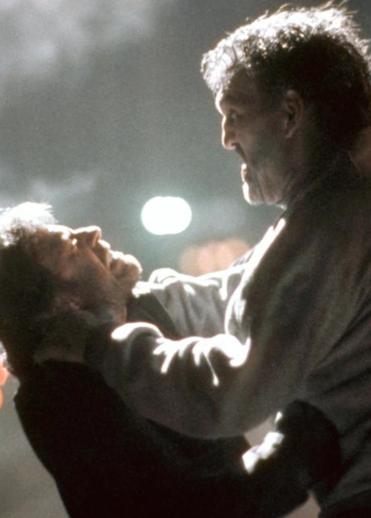Sunday, September 18, 1988.
HERO AND THE TERROR. Written by Dennis Shryack and Michael Blodgett, based on Blodgett’s 1982 novel. Directed by William Tannen. Running time: 96 minutes. Rated 14 Years Limited Admission with the B.C. Classifier’s warning: some violence, some very coarse language.
Reviewed with:
BLINDSIDE. Written by Richard Beattie. Music by Paul Zaza. Directed by Paul Lynch. Running time: 98 minutes. Restricted entertainment with the B.C. Classifier's warning: some violence, nudity and suggestive scenes.
DESTROYER. Written by Peter Garrity, Rex Hauck and Mark W. Rosenbaum. Directed by Robert Kirk. Running time: 94 minutes. Restricted entertainment with the B.C. Classifier's warning: frequent violence, very coarse language, occasional nudity.
A NIGHTMARE ON ELM STREET 4: THE DREAM MASTER. Written by Brian Helgeland and Scott Pierce. Music by Craig Safan. Directed by Renny Harlin. Running time: 93 minutes. Restricted entertainment with the B.C. Classifier's warning: frequent gory violence, occasional nudity and very coarse language.
THE DEATH TOLL IS ENORMOUS. In just four features, some 34 lives are snuffed out in graphic detail for the delectation of filmgoers.
The guilt felt by the guilty is nil. In three of the four pictures, the villain is a serial killer with powers bordering on the supernatural.
The Destroyer is Ivan Moser (Lyle Alzado), convicted slayer of 22, who survived the electric chair. Described as “half-alive,” this massively muscled behemoth lurks about an abandoned state prison awaiting fresh prey.
"Terror" Simon Moon (Jack O’Halloran), did away with 23 before being committed to a facility for the criminally insane. A hulk with “no thought processes,” he escapes to kill again in Hero and the Terror.
Freddy Krueger (Robert Englund), the dream demon who specializes in teen terminations, has a rap sheet going back three films. "I am eternal!’’ he boasts to 17-year-old Alice Johnson (Lisa Wilcox) in A Nightmare on Elm Street 4: The Dream Master.
Only Blindside, director Paul Lynch’s dull, Canadian-made thriller, offers reasonably mortal villains. A low-rent reprise of Francis Ford Coppola’s The Conversation (1974), Lynch's picture features Harvey Keitel as Penfield Gruber, a morose professional snoop caught in a web of gangland betrayal and assassination.
In common with Krueger, Moon and Moser, Lynch’s killers are uniformly amoral and without conscience as they “whack” one another with maniacal glee. The mood of the film, though, is utterly gloomy, reflecting the depressed Gruber’s conviction that people are awful.
Since Blindside's bad guys are all drug dealers, it's possible to read into their ends a minor moral lesson. By contrast, the other movies' villains deal exclusively in death.
Despite the relentless pursuit of soulful rogue cop Dan O'Brien (Chuck Norris), the deranged Moon gets to snap a selection of (mostly female) necks before he faces down the hero.
Moser manages to wipe out most of an exploitation film crew working on location in his prison hideout. Krueger, adding gallows humour to his repertoire, continues to deplete Springwood’s adolescent population.
Worth noting, perhaps, is the fact that both Moser and Krueger are bested by self-reliant female characters. (Deborah Foreman’s Susan Malone in Destroyer; Wilcox’s Johnson in Nightmare 4).
As welcome as this is as a film trend, it’s overshadowed by the realization that these movies are offering mass murder as entertainment. Taken individually or together, this stuff is sick.
The above is a restored version of a Province review by Michael Walsh originally published in 1988. For additional information on this archived material, please visit my FAQ.
Afterword: It hardly seemed safe to set foot on Vancouver’s Theatre Row during the first week of autumn, 1988. Mass murderers lurked in almost every movie house, it seemed. Overwhelmed, I offered up the above package review expressing my disappointment with the lot. If I’d written a full review of Hero and the Terror, I might have mentioned all the trouble the film goes to to associate homicidal mania with entertainment sites. The film opens with title character Simon Moon (the Terror) using an abandoned amusement park as his base of operations. After his escape, he holes up in a movie theatre.
It was award-winning TV adman William Tannen’s third feature film, and perhaps something in Michael Blodgett’s 1982 novel spoke to him. Then again, he might have been introduced to the idea by Blodgett’s screenwriting partner, Dennis Shryack, who five years earlier had provided Tannen with the script for his debut film Flashpoint, a suspense thriller based on the “second gun” theory that arose after the Kennedy assassination in Dallas.
Given that Tannen was by all accounts politically liberal, there may have been some tension on the set with Hero star Chuck Norris, an outspoken Evangelical Christian and Republican supporter. Norris was, of course, one of those second tier action stars that emerged in the 1980s, the guy producers went to when they couldn’t afford Stallone, Schwarzenegger, Clint Eastwood or Bruce Willis. Along with Jean-Claude Van Damme, Dolph Lundgren and Steven Segal, he had enough martial arts training to hold his own in a fight scene, but not enough personal charisma to upstage the set design. As expected, Terror actor Jack O’Halloran stole what show there was to steal.
